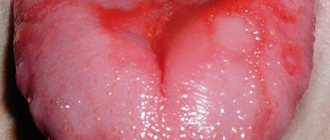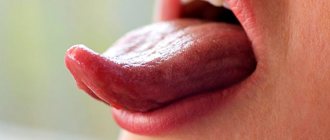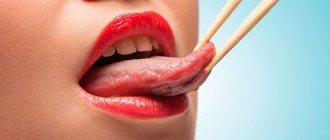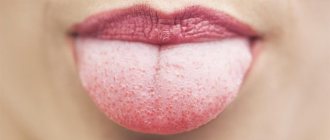What does it represent?
The more common name for desquamative glossitis - “geographic tongue” - appeared and came into use due to its most characteristic manifestations - the appearance of foci of inflammation on the tongue, which are bordered by white exfoliating epithelium.
Because of this, the appearance of the language begins to resemble a three-dimensional geographical map. Areas of exfoliation and inflammation can appear in a completely random order, both on the back of the tongue and on its lateral surfaces
.
Course of the disease
Photo: what a geographic tongue looks like
The process of desquamation of the epithelium (epithelium is the upper layer of all surfaces of the body, as well as mucous membranes and organs) can last for varying periods of time - from several days to several months. Sometimes even longer.
Usually the little patient does not experience strong discomfort
. However, those areas that are practically unprotected due to the fact that the top layer is exfoliated are highly susceptible to all kinds of infections. If infection occurs, the child’s tongue may become covered with cracks, which lead to quite painful sensations.
Prevention
To prevent the occurrence of desquamative glossitis in a child, as well as to quickly cope with it in its initial phase, you can use a number of folk methods and recipes. For example, rinsing the mouth with water with a few drops of iodine and a pinch of baking soda, as well as decoctions of such natural remedies as:
- Oak bark;
- calendula flowers;
- sage;
- chamomile;
- rose hip;
- tea tree;
- sea buckthorn.
Also, applications made from gauze cloth lubricated with petroleum jelly or fish oil will bring considerable benefit to an inflamed child’s tongue, but you should not keep such a lotion on the affected area for more than five minutes.
Tartar and caries can provoke desquamative glossitis, so at least once every six months, the child should be taken to the dentist for an examination, and he should also be taught in time all the rules for brushing his teeth and tongue.
Previous article
Children's dentistry
Next article
Dental prosthetics
Symptoms
Most often, neither the children themselves nor the parents notice either the onset of the disease or its course until a certain time. Identification occurs in most cases completely by accident - at a dentist’s appointment or an examination of the oral cavity by a general practitioner.
Sometimes older children can notice the problem on their own, for example, during daily oral hygiene procedures or by carefully looking at the tongue in the mirror.
Do you know when to start brushing your child’s teeth? The answer can be found in our article.
We will tell you in detail why a black coating occurs on the tongue in children.
At this address: https://www.vash-dentist.ru/detskaya-stomatologia/polost-rta/tantum-verde-dlya-detey-instruktsiya-po-primeneniyu.html - you will find instructions for using the drug Tantum Verde.
Main symptoms
- the appearance of areas of white-gray clouding of the surface of the tongue;
- swelling and then desquamation of the affected areas of the epithelium;
- the appearance of red or bright pink spots that have different sizes and shapes;
In those areas where desquamation occurs, the mushroom-shaped papillae of the tongue become very visible. They look like bright red dots. Quite rarely, areas of desquamation appear alone. Most often these are numerous lesions on different parts of the tongue.
Possible manifestations
- increased sensitivity of the surface of the tongue;
- burning sensation;
- itching;
- numbness;
- tingling;
- change in sensitivity;
- changes in the perception of taste;
- increase in size due to multiple foci of inflammation and desquamation;
- discomfort during a conversation;
- difficulty swallowing and chewing food;
- headache;
- enlargement of nearby lymph nodes;
- general deterioration of health.
Children often feel very anxious about the appearance of their tongue. This leads to stress, and stress can lead to a significant worsening of the disease. If the process worsens, the strength and speed of desquamation also increases
.
In almost half of the cases this leads to a manifestation such as a folded tongue
– the general shape changes, folds appear on the surface due to multiple foci of desquamation.
How it manifests itself
The disease looks like thickenings and spots on the tongue. At the site of the spots, peeling of the mucous membrane and significant peeling are visible. The thickenings are bright red and have a white rim. The shape of the spots is mostly irregular. The disease affects the visible surface of the tongue and the sides. The general appearance of the surface of the mucous membrane resembles a geographical map (which is why the disease received such an interesting name). “Islands on the map” often heal and move to other places, that is, the disease is migratory in nature.
The following process of disease development is known:
- Appearance of a whitish-gray area. The type of area is round or oval with a diameter of several millimeters.
- Swelling of the area, desquamation of filiform papillae and the appearance of a bright red zone. The area appears to have a slightly elevated appearance.
- The area begins to grow very quickly, sometimes taking on the appearance of rings or buttons. Round shapes are preserved.
- The zone can have different shapes. It looks like red spots.
- When the lesion grows to a significant size, the boundaries blur on the surface.
- The pattern on the tongue may change daily.
- At the last stage of the disease, the lower surface of the tongue is affected.
In 99% of cases, patients have no complaints of discomfort. Usually the disease is detected by visual examination by the patient himself or the attending physician. The geographic tongue does not cause any discomfort or pain. But there are rare exceptional cases when the following symptoms appear when eating spicy, too salty, too hot or unpleasantly cold food, as well as poor hygiene: burning, itching, changes in sensitivity and slight tingling
Children often pay attention to the strange appearance of the tongue.
Diagnosing the disease is not difficult. The diagnosis is based on the following factors:
- Visual inspection data.
- Data from the medical history of the disease and the patient’s life.
- Listening to possible complaints and observations of the patient.
The disease is not limited in time. Most often, people suffer from this disease from 2 weeks to 10 years. It happens that visible signs disappear for an indefinite period of time, and then appear again.
Reasons for appearance
The complete list of causes and factors that lead to this disease is still not fully known. Many specialists, incl. and the well-known Dr. Komarovsky, they say that a child’s geographic tongue is most often associated with certain groups of general diseases of the body.
The basis for the occurrence of desquamative glossitis is serious disruptions in the nutrition of cellular tissues, that is, a violation of the trophic (that is, nutritional) function of the mucosa.
- Exudative diathesis. Some children have a tendency to various kinds of inflammatory diseases that affect the skin and mucous membranes. This is the most common and probable cause of this disease in children.
- Diseases that arise due to a lack or disruption of metabolic processes of B vitamins:
- B1 – disruption of the normal functioning of important body systems - digestive, as well as nervous and cardiovascular (beriberi disease);
- B2 – all kinds of changes and lesions of the mucous membrane of the tongue, lips and oral cavity, which are inflammatory in nature (bleeding, glossitis, cracks, burning);
- B6 – various skin lesions (wounds, cracks and scratches that do not heal for a long time, dryness);
- B12 – megaloblastic anemia (disorder of hematopoietic processes in the bone marrow).
- Diseases that affect the gastrointestinal tract:
- various types of hepatitis;
- malabsorption syndrome (changes in the normal functioning of the intestine - disruption of transportation, absorption of food in the large intestine, as well as its digestion);
- diseases of the stomach, as well as the duodenum (various gastritis);
- gastroduodenitis, stomach and/or duodenal ulcer.
- Diseases affecting the pancreas:
- diabetes;
- pancreatitis (chronic, acute and recurrent forms);
- tumor neoplasms.
- Some diseases that are associated with the endocrine system of the body and its organs - the thyroid, pancreas and adrenal glands.
- Autoimmune diseases (too strong immunity, the work of which is already directed against one’s own body):
- Lupus erythematosus is a systemic disease in which damage to connective tissue, as well as blood, begins to appear;
- Rheumatoid arthritis is damage to the small joints of the tissues that form the framework for organs.
We will talk about the possible reasons for the appearance of a yellow coating on a child’s tongue, and how to treat it.
This article lists approved toothache medications for children.
At the following address: https://www.vash-dentist.ru/detskaya-stomatologia/d-zubi/uhod-za-dz/elektricheskaya-shhetka-kak-pravilno-vyibrat-dlya-raznogo-vozrasta.html - you will find out how to choose an electric toothbrush for a child
- Complex forms of various viral infections:
- ARVI with complications;
- infectious mononucleosis - changes in blood composition, damage to lymph nodes, liver.
- Some diseases of the oral cavity, for example, scrotal congenital tongue.
In addition to general diseases, there are some other factors that can also cause the appearance of desquamative glossitis.
- Use in large doses, as well as uncontrolled use of antibiotics to treat other diseases.
- Hereditary factor.
- The child’s body reacts too strongly to vaccinations.
- Eruption of baby teeth. This is a very likely factor for a certain age group of children, mainly from six months to 4 years. Usually, after eruption is completed, the symptoms of the disease disappear. If not, then the reason is other diseases that require separate treatment.
- Children are also characterized by the appearance of desquamative glossitis due to helminthic infestation (worms), which cannot be eliminated for a long time.
- Mechanical damage to the surface of the mucous membrane of the tongue of varying complexity.
Red spots
If red areas appear on the tongue, there may be several reasons for their appearance. The location of the spots, their size, as well as accompanying symptoms should be assessed. For the most part, diseases that turn the tongue red can be divided into four groups:
Read also: How to treat stomatitis in a 2-year-old child
- scarlet fever;
- abnormalities in the gastrointestinal tract;
- allergy;
- herpes.
The appearance of red areas on the tongue may indicate scarlet fever
Scarlet fever
If the baby's tongue suddenly turns red, there is a possibility that this is how scarlet fever manifests itself. The markings are bright, noticeable, and resemble strawberries in color and shape. A photo of a tongue with red “strawberry” spots can be found in any medical reference book. In addition to changes in the color of the tongue, fever, cough, pain when swallowing and rash are possible. This disease is quite common among children attending preschool. As a rule, quarantine is immediately introduced in kindergarten, since the causative agent of scarlet fever, beta-hemolytic streptococcus, is transmitted by airborne droplets. Most often, this disease affects children 2-4 years old; it almost never occurs in adults.
Scarlet fever needs to be treated competently - follow the medication and food intake regimen. A course of antibiotics is usually prescribed
In addition, it is important to maintain bed rest and drink plenty of fluids, then toxins will be eliminated from the body faster. In severe cases, therapy is carried out in a hospital setting
Usually after two weeks the child makes a full recovery. During this period, the temperature drops, the tongue will acquire a normal color.
However, scarlet fever can cause complications, so it is extremely important that the diagnosis is made by a doctor, and he is also involved in treatment
Geographic spots
Sometimes spots on the tongue have an irregular shape and are somewhat reminiscent of a geographical map. The layers may have a yellow edging, and if you look closely at the surface of this organ, you can see that some papillae differ in shape from their “brothers”. In addition, spots can change location from day to day, sometimes disappearing without a trace. These symptoms may indicate gastrointestinal or liver diseases. At the same time, on Dr. Komarovsky’s website there is information that geographic tongue in most cases does not require treatment - often such symptoms are not a sign of a serious illness.
However, sometimes this picture is observed in infants during the period of dentition (teething), as well as in older children who lack vitamins. Often the child complains of pain and a burning sensation on the tongue while eating, especially when it comes to sour or spicy foods. Having noticed a geographical pattern on the tongue, you need to show the baby to the pediatrician and pay more attention to his diet.
Geographic tongue is most often not a deviation from the norm, but it is advisable to show the child to a doctor
In a child suffering from allergies, during moments of exacerbation, not only the cheeks, but also the tongue may turn red. There are few reddened areas, only 2-3, but it happens that the entire surface of this organ is painted with a bright color. Parents should monitor the baby's diet and try to identify the allergen. If the product is unknown, first you should remove from your diet everything that is highly allergenic - nuts, eggs, chocolate, citrus fruits, red apples. Recently, cases of allergies to halva made from sunflower seeds have become more frequent (we recommend reading: can a nursing mother eat halva while breastfeeding?). As soon as the allergen is excluded from the menu, the rash on the body and spots on the tongue will disappear. Later, when the child grows up and strengthens the immune system, the allergy may disappear.
One of the manifestations of herpes zoster is red spots on the sides or tip of the tongue. They can turn into sores, itch, or be almost invisible. In addition, a rash may appear on the child’s body, which often affects only one side. This disease rarely occurs in children, more often in adults. Its symptoms indicate low immunity. According to experts, the herpes virus lives in the body of most of the world's population, but in many people it does not manifest itself in any way.
It is worth remembering whether the baby had contact with a person who has chickenpox. The causative agent of herpes is a close relative of this disease. An infant whose mother had chickenpox during pregnancy is also often diagnosed with herpes. In any case, you need to consult a pediatrician who will prescribe adequate treatment.
Treatment
It is impossible to describe one treatment option, since the measures taken in a particular case are entirely individual. This happens due to a huge number of possible reasons.
If the disease was caused by any general disease, then, first of all, it should be treated. Since without eliminating the cause, local treatment of geographic tongue is useless.
However, there are a number of therapeutic measures that should be carried out in any case, regardless of what caused the occurrence of desquamative glossitis.
- Sanitation of the oral cavity - identification and treatment of caries (for baby teeth this is as important as for permanent teeth), removal of plaque and all kinds of deposits, regular cleaning of the entire oral cavity using professional methods, as well as careful self-hygiene.
- To maintain internal balance and enhance the body's protective properties, it is recommended to take multivitamin complexes.
- After the first symptoms appear, alkaline rinses are desirable.
- If itching, pain, burning or other unpleasant symptoms occur, you can use analgesic (painkiller) applications of various drugs on the affected surface of the mucosa.
- Antiseptic rinses.
- Therapy that reduces the body's allergic activity and its manifestations.
You should not neglect seeing a doctor and treating geographic tongue, even if this disease does not manifest itself in any way, except for exclusively external, visible symptoms.
Diagnosis by a specialist is extremely important, since this disease can be an indicator of other, more serious and dangerous ones that require mandatory medical examination and treatment.
Home treatments
Traditional medicine also has some methods and recipes used for desquamative glossitis. Almost all of them are aimed at alleviating discomfort and getting rid of external symptoms.
- Rinse
. Add 2-3 drops of iodine and half a small spoon of soda to a glass of warm water - you should rinse your mouth with this solution twice a day, after brushing your teeth. Pure vegetable oil, sterilized in a water bath (the duration should be at least half an hour), after cooling, can also be used for rinsing.The duration of this procedure should be at least 2 minutes. Rinsing with decoctions of herbs that have an antiseptic effect - chamomile, St. John's wort, sage and others.
- Lotions
made from gauze napkins, pre-moistened with oils (vaseline or peach), fish oil. Apply gauze for 3-5 minutes. - Special oral baths
. To do this, you need to take sunflower oil (or other vegetable oil) boiled for 20 minutes in a water bath and cool it. After cooling completely, a small amount (1.5–2 tablespoons) is taken into the mouth for 5–10 minutes and then spat out.
If you find an error, please select a piece of text and press Ctrl+Enter.
Tags: geographic language for children language
Did you like the article? stay tuned
Previous article
When can you start brushing your child’s teeth?
Next article
Oral irrigator Aquajet (Akvadzhet)
Home methods
In general, people who develop this disease do not require special treatment or medical intervention. The epithelium peels off within a few weeks or months, and everything disappears on its own. But what treatment is needed when it has been bothering you for quite a long time and there is no visible path to recovery?
The most important thing for the treatment and prevention of geographic tongue is constant oral hygiene. It is especially important for children with a folded tongue, since such structural features are very suitable for the development of bacteria, which, together with glossitis, can lead to inflammation, which is accompanied by pain
Treatment of geographic tongue in both children and adults should begin with rinsing with a variety of herbs and tinctures. Decoctions of chamomile and St. John's wort have a very good effect.
Sunflower oil also has medicinal qualities, so doctors recommend keeping it in your mouth for up to ten minutes. But first it needs to be sterilized. To do this, the bottle is placed in boiling water and removed only after twenty minutes. Rinsing your mouth with fresh green tea reduces inflammation and relieves discomfort.
Fish oil, oil, and Vaseline, which is soaked in a gauze pad and applied to the tongue, can also help a lot. You need to keep this gauze for 5 minutes.
To avoid further exacerbations or recurrence of the disease, it is better to limit children to spicy, salty and very cold, hot foods.
In this way, with the right actions on time and following hygiene rules, geographic tongue will not cause any harm to your baby.
Disquamative glossitis usually goes away on its own, and by focusing on it, you may miss a really serious disease that could provoke the appearance of a geographic tongue. Therefore, it is necessary to find out the reasons through examination.
The doctor will identify possible causes and prescribe the correct treatment. The main thing is to follow all his recommendations and then all the symptoms - spots, redness, enlargement of the tongue - will gradually pass and no serious changes will occur in the child’s health.
Fortunately, the treatment of geographic tongue is mostly done without medications, which is undoubtedly a plus.
The main thing is to teach your child the rules of personal hygiene from early childhood. And not just tell them that you need to brush your teeth twice a day and change your toothbrush every three months, but also demonstrate all this by example.
Sometimes geographic tongue is not a symptom of any disease, then it makes sense to use home treatment methods. It is worth noting that most of the folk recipes can significantly alleviate the patient’s condition, since they are symptomatic therapy. In particular, it makes sense to turn to them if the problem causes discomfort in the form of itching, pain while eating, etc. Recipes for home remedies:
- Rinse with a solution of iodine and soda. You need to dissolve 2 drops of iodine and half a teaspoon of soda in a glass of water. Rinse your mouth twice a day after meals.
- Vegetable oil is also used for rinsing the mouth. However, it must be sterilized first. To do this, the oil must be placed in a steam bath for 30 minutes.
- You can rinse your mouth with medicinal herbs - use St. John's wort, chamomile, oak bark. Any rinsing should be done for 2 or more minutes, and after that, do not eat for 15 minutes.
- Gauze napkins soaked in oil—vaseline, rosehip, peach, or fish oil—have medicinal properties. They must be applied to the tongue for 5-10 minutes.
- Baths for the oral cavity. They will need vegetable oil, which must be kept in a water bath for 30 minutes to sterilize. Place warm (not hot) oil in your mouth for 3-5 minutes and spit out.
- Traditional healers recommend keeping honey in your mouth, dissolving it gradually. The tasty medicine has bactericidal and healing properties. In addition, honey improves immunity. Another beekeeping product, propolis, also provides a powerful healing effect. Alcohol tincture (1 tsp) should be added to water (200 ml) and rinse the mouth with this solution.
Honey is a tasty and healthy medicine for the tongue, but before use you need to make sure that the child is not allergic to bee products
Write a comment
Svetlana
March 16, 2015 at 6:49 am
The cause of geographic tongue can indeed be several diseases. But mainly this is a problem of the gastric tract. And first of all, such an unpleasant disease as gastroesophageal reflux. This is when the contents of the stomach are thrown back into the esophagus and even the oral cavity. This can be complicated in addition bile reflux, when bile from the duodenum is thrown into the stomach and esophagus. So you should definitely contact a gastroenterologist, because if the disease becomes chronic, then it’s just torment, as it is accompanied by constant heartburn and burning in the esophagus and oral cavity. So that the most important thing is to start treating it right away; for this, the doctor will prescribe medications and a strict diet. So you should always monitor the child’s tongue.
Tatiana
May 30, 2015 at 11:04 am
In addition to rinsing with soda, chlorgrexidine lotions also help. In my case, this disease is caused by stress and manifests itself when the body is weakened - nervous overstrain or a cold.
Nadia
January 1, 2016 at 10:04 pm
Hello! My son is 3 years old. He has a geographic tongue. Our doctor always tells me to just rinse when I come. Spots appear periodically, and recently I began to notice that with the appearance of spots on my son’s tongue, his bowel movements are disturbed. But there are no complaints from him arrived.
Olga
August 28, 2016 at 6:15 pm
My son’s geographic tongue was noticed by a dentist during an appointment. I had never even heard of this before, and I didn’t know that, to be honest, there are different languages. Nothing bothered my son, there were no complaints. The dentist said that there is nothing wrong, the main thing is to find out the reason. Perhaps it’s untreated teeth, or a lack of vitamin B. We fixed all the teeth, and after a while I noticed that my son’s tongue became even.
Irina
September 4, 2016 at 12:19 pm
My sister also had a similar experience in childhood, but they did nothing, they didn’t even pay attention to this fact. As she grew older, everything disappeared; now her language is normal, like all other children. Therefore, I am inclined to conclude that with age, geographic tongue goes away on its own without any treatment. So there’s nothing to be afraid of, at least it’s passed for us.
Nata
February 8, 2022 at 0:02
My youngest had this condition of his tongue a couple of years ago, I noticed it by chance when I was brushing my teeth, but not as bad as in the pictures, there were smaller marks. I didn’t immediately understand what was wrong, I thought it was burned with something like acid, especially since before that I had complained a little about my stomach. We rushed to the doctor, it turned out to be worms, we were treated and everything went away, the tongue returned to normal. But the doctor also explained to me that such symptoms occur for various reasons, so if suddenly this appears on a child’s tongue, you don’t need to wait until it goes away on its own, but immediately consult a doctor.
Doctor Komarovsky's opinion
Well-known pediatrician and TV presenter Evgeny Komarovsky advises not to panic about geographic tongue - this phenomenon does not pose a danger to the child. This doesn't mean you should ignore it. An examination will not hurt, since there are reasons for the strange coloring of the surface of a child’s tongue. In the meantime, while the examination is underway, the parent needs to take several measures that will help cope with the annoying problem faster and more efficiently:
it is important to give the child soft food so that he does not have the opportunity to scratch or injure his tongue with rough, hard food; You should not give your child anything too salty, spicy or sour - additional irritation of the tongue is absolutely useless; if there is itching, it is important to ensure that the child does not scratch the tongue or drag foreign objects into the mouth - the presence of wounds on the lingual surface can be complicated by infection; it is important to consult a pediatrician about vitamins - very often the geographical language indicates the presence of one or another type of vitamin deficiency; There is no need to rush to intensively treat the child with medications - in most cases, home rinses and lotions are enough to rid the child of a strange pattern on the tongue in a couple of weeks.
Black hairy tongue (lingua villosa nigra)
Black hairy tongue
Black hairy tongue, or lingua villosa nigra in Latin, is a generally painless and harmless condition characterized by the appearance of a black, moss-like coating.
The nature of the problem usually consists of two conditions - the papillae (taste buds) acquiring a blackish or brownish color and their growth in length. The black, hairy appearance of the tongue can be alarming and bothersome, especially when accompanied by bad breath and a feeling of nausea.
Causes
A black hairy tongue occurs due to the accumulation of bacteria, food debris, and other microorganisms on the papillae. The hairy appearance is therefore acquired as a result of the elongation of the papillae themselves when they are unable to rid themselves of accumulated debris. Why this happens is not entirely known, but here are some potential factors that may cause a black hairy tongue:
- insufficient and poor oral hygiene is the main cause of a furry tongue in many cases;
- excessive consumption of coffee along with frequent smoking of tobacco, including cigarettes;
- reaction to certain medications, e.g. those containing bismuth or antimicrobial components, such as tetracycline;
- regular use of mouthwash containing oxidizing and astringent agents such as methanol, witch hazel and peroxide;
- decreased saliva production or flow rate;
- black hairy tongue is also common in people without teeth, as they eat soft foods that are not abrasive to the surface of the tongue (soft foods do not remove dead cells);
- A weakened immune system, which may be caused by HIV/AIDS or diabetes, is also likely a factor;
- dry mouth.
Treatment
Usually, black hairy tongue goes away on its own, but you can speed up the process by eliminating some of the factors that may trigger its occurrence. During treatment, the goal is to restore the normal color or appearance of the affected tongue. Here are the best methods for treating black hairy tongue:
Regular brushing of teeth, mouth and tongue
Regular brushing of your teeth, gums and tongue with a soft-bristled brush will help get rid of accumulated bacteria and food debris on the tongue, hence preventing the problem from developing.
Moisturizing the mouth
You can prevent dry mouth by drinking enough water. Remember that when the oral cavity is not sufficiently moistened, the growth of bacteria and other microorganisms increases and their accumulation in the papillae. Therefore, keeping your mouth hydrated is very important.
Diagnostics
Performed in a hospital. To diagnose the disease, the child is examined by a doctor, then blood, urine and stool tests .
Laboratory tests help not only diagnose the disease, but also determine the cause of its occurrence. Usually, after the first visit to the hospital, it is possible to make a diagnosis and prescribe the optimal treatment method.
How to treat plantar warts in children? Find out about this from our article.








